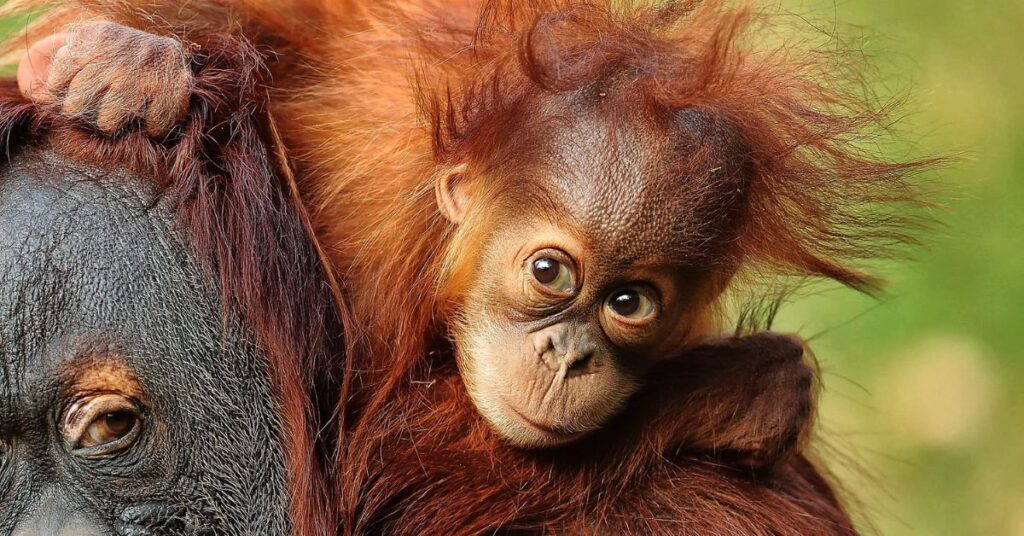Have you ever wondered what makes baby orangutans so special? These adorable creatures are not only captivating in their appearance but also fascinating in their behavior and development. From their unique parenting styles to the challenges they face in the wild, baby orangutan offer a glimpse into the intricate lives of one of our closest relatives in the animal kingdom. In this article, we will explore the world of baby orangutans, their habitats, diets, and the critical conservation efforts needed to ensure their survival.
What Are Baby Orangutans?
Baby orangutan, known as infants, are the young of the orangutan species, primarily found in the rainforests of Indonesia and Malaysia. They belong to the great ape family, which also includes gorillas, chimpanzees, and bonobos. At birth, baby orangutans are incredibly vulnerable, weighing around three to four pounds and depending entirely on their mothers for survival.
Physical Characteristics
Baby orangutans have distinctive features that set them apart from other primate infants. Their bodies are covered in a soft, orange fur that becomes denser as they grow. Their large, expressive eyes and small noses make them particularly charming. Additionally, baby orangutans have long limbs, which they will use to swing through the trees as they grow older.
The Early Life of a Baby Orangutan
The first few years of a baby orangutan’s life are crucial for their development. During this period, they learn essential survival skills from their mothers. These skills include foraging for food, navigating the treetops, and recognizing potential dangers.
Maternal Care
Mother orangutans are known for their exceptional parenting skills. They nurture their babies for an extended period, often up to six years. This extended care allows the infants to develop the skills they need to thrive in the wild. Mothers will carry their babies on their bodies, using a unique position on their hip or back, while teaching them how to find food and interact with their environment.
Play and Socialization
Baby orangutan are playful by nature. They engage in social play with their mothers and other young orangutans, which is crucial for their cognitive and social development. This playtime helps them learn about their surroundings and practice essential skills for when they become independent.
Diet of Baby Orangutans
The diet of a baby orangutan primarily consists of fruits, leaves, and insects. As they grow, their diet expands to include more variety. Understanding their dietary needs is vital for their health and development.
Nutritional Needs
Baby orangutans rely on their mother’s milk for the first few months of life. Once they are weaned, usually around two to three years, they begin to explore solid foods. Their diet will include:
- Fruits: Orangutans are frugivorous, which means fruits make up the majority of their diet. Common fruits include durian, figs, and mangoes.
- Leaves: Young orangutans also consume tender leaves, which provide essential nutrients and fiber.
- Insects: Occasionally, baby orangutans will eat insects for additional protein.
This diverse diet is essential for their growth and development, supporting their energetic lifestyle as they climb and explore.
Behavior and Development
The behavior of baby orangutans is a subject of extensive study. As highly intelligent creatures, they exhibit a range of behaviors that highlight their adaptability and cognitive abilities.
Climbing and Swinging
From a young age, baby orangutans begin to practice climbing. They develop strong muscles and coordination through playful swinging and climbing in the trees. These activities are not only fun but also critical for their future survival in the wild, as they will need these skills to escape predators and find food.
Communication
Baby orangutans are vocal and communicate through a variety of sounds. They use vocalizations to express their needs and emotions, such as distress, excitement, or curiosity. These early forms of communication are vital for building relationships with their mothers and other orangutans.
The Threats Facing Baby Orangutans
Despite their charm and intelligence, baby orangutans face numerous threats in the wild. Understanding these challenges is essential for conservation efforts aimed at protecting their populations.
Habitat Loss
One of the most significant threats to baby orangutans is habitat loss due to deforestation. Logging, palm oil plantations, and agricultural expansion have led to a drastic reduction in their natural habitat. As their living spaces shrink, orangutans are forced to travel farther to find food, increasing their risk of conflict with humans.
Illegal Wildlife Trade
Baby orangutans are also vulnerable to poaching and illegal wildlife trade. Their appealing appearance makes them targets for the pet trade, leading to the removal of these infants from their mothers. This not only harms the individual baby but also has devastating effects on the population as a whole, as mothers may die trying to protect their young.
Conservation Efforts
Conserving baby orangutans and their habitats requires a multifaceted approach that involves local communities, governments, and international organizations.
Habitat Protection
One of the most effective ways to protect baby orangutans is by preserving their natural habitat. Initiatives that focus on sustainable logging practices and reforestation efforts are crucial. Organizations are working with local governments to establish protected areas where orangutans can thrive without the threat of deforestation.
Rehabilitation and Release Programs
Organizations dedicated to orangutan conservation often operate rehabilitation centers for orphaned or rescued orangutans. These centers provide care, nutrition, and education on survival skills before releasing the animals back into the wild. These efforts help to ensure that the baby orangutans grow into healthy adults capable of surviving in their natural environment.
Community Involvement
Engaging local communities is vital for successful conservation. By educating residents about the importance of orangutans and their habitats, conservation organizations can foster a sense of responsibility and stewardship. Community-led initiatives can also promote sustainable practices that benefit both wildlife and people.
The Role of Education and Awareness
Raising awareness about the challenges faced by baby orangutans is essential for building support for conservation efforts. Education programs can inform people about the importance of biodiversity and the role orangutans play in their ecosystems.
Advocacy and Support
Individuals can play a role in orangutan conservation by supporting organizations dedicated to their protection. This can include donations, volunteer work, or simply spreading the word about the challenges these animals face. The more people know about baby orangutans and the threats they encounter, the more likely they are to take action.
Visiting Sanctuaries and Reserves
For those interested in learning more, visiting sanctuaries or reserves that care for orangutans can provide valuable insight. Observing these magnificent creatures in a responsible setting allows individuals to appreciate their beauty while supporting conservation efforts directly.
Conclusion
Baby orangutans are extraordinary creatures that capture our hearts with their playful behavior and endearing appearance. However, they face significant threats that require our immediate attention. By understanding their needs, the challenges they encounter, and the conservation efforts underway, we can all contribute to ensuring a brighter future for these incredible animals. Together, we can protect the habitats they rely on and support the organizations working tirelessly to conserve this species for generations to come.







